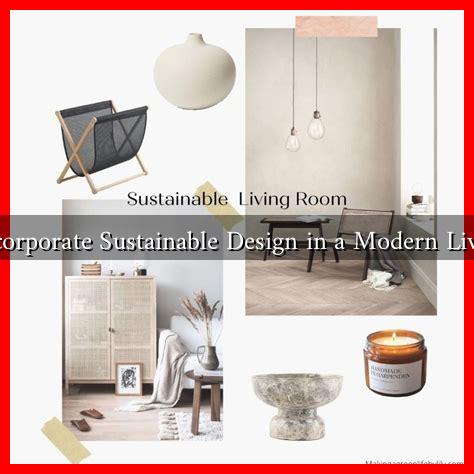-
Table of Contents
How to Incorporate Sustainable Design in a Modern Living Room
As environmental concerns continue to rise, the demand for sustainable design in our homes has never been more critical. The living room, often the heart of the home, presents a unique opportunity to embrace eco-friendly practices while maintaining a modern aesthetic. This article explores various strategies to incorporate sustainable design into your living room, ensuring that style and sustainability go hand in hand.
Understanding Sustainable Design
Sustainable design focuses on creating spaces that minimize environmental impact while promoting health and well-being. It involves using materials and practices that are environmentally friendly, energy-efficient, and socially responsible. According to the U.S. Green Building Council, buildings account for 39% of carbon emissions in the United States, making sustainable design essential for reducing our carbon footprint.
Choosing Eco-Friendly Materials
One of the most effective ways to create a sustainable living room is by selecting eco-friendly materials. Here are some options to consider:
- Bamboo: A fast-growing, renewable resource that is durable and stylish.
- Reclaimed Wood: Using salvaged wood reduces deforestation and adds character to your space.
- Low-VOC Paints: Volatile organic compounds (VOCs) can harm indoor air quality. Opt for low-VOC or zero-VOC paints.
- Natural Fabrics: Choose organic cotton, linen, or hemp for upholstery and curtains to avoid harmful chemicals.
Energy Efficiency and Lighting
Lighting plays a crucial role in both the functionality and ambiance of a living room. To enhance energy efficiency, consider the following:
- LED Bulbs: These consume up to 75% less energy than traditional incandescent bulbs and last significantly longer.
- Smart Lighting: Install smart bulbs or systems that allow you to control lighting remotely, reducing energy waste.
- Natural Light: Maximize natural light by using sheer curtains and strategically placing mirrors to reflect light.
Furniture Selection and Arrangement
When it comes to furniture, sustainability can be achieved through thoughtful selection and arrangement:
- Second-Hand Furniture: Thrift stores and online marketplaces often have unique pieces that are both affordable and eco-friendly.
- Modular Furniture: Choose furniture that can be easily reconfigured or repurposed, reducing the need for new purchases.
- Local Artisans: Support local craftsmen who use sustainable practices and materials, reducing transportation emissions.
Incorporating Plants for Air Quality
Adding plants to your living room not only enhances aesthetics but also improves air quality. According to a study by NASA, certain houseplants can remove toxins from the air. Consider these options:
- Snake Plant: Known for its air-purifying qualities and low maintenance.
- Pothos: A hardy plant that thrives in various conditions and helps filter indoor air pollutants.
- Spider Plant: Effective at removing formaldehyde and other harmful chemicals.
Case Studies: Successful Sustainable Living Rooms
Several designers and homeowners have successfully integrated sustainable design into their living rooms. For instance, the Sustainable Home Project in California showcases a living room that utilizes reclaimed materials, energy-efficient appliances, and a biophilic design approach that connects the indoors with nature. This project not only reduces environmental impact but also creates a serene and inviting atmosphere.
Conclusion
Incorporating sustainable design into your modern living room is not only beneficial for the environment but also enhances your quality of life. By choosing eco-friendly materials, optimizing energy efficiency, selecting sustainable furniture, and adding greenery, you can create a stylish and responsible living space. As we move towards a more sustainable future, every small change counts. Embrace these practices to make your living room a model of modern sustainability.

